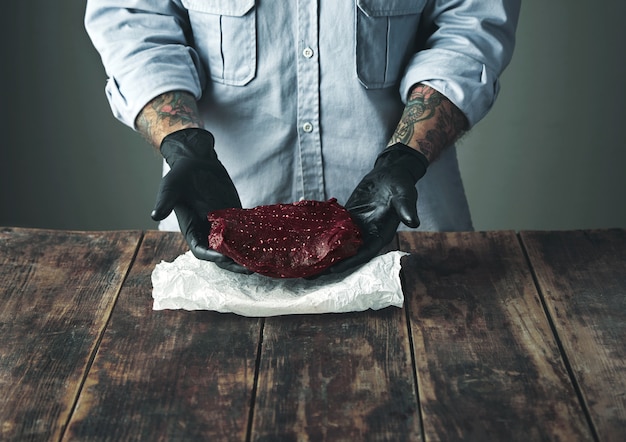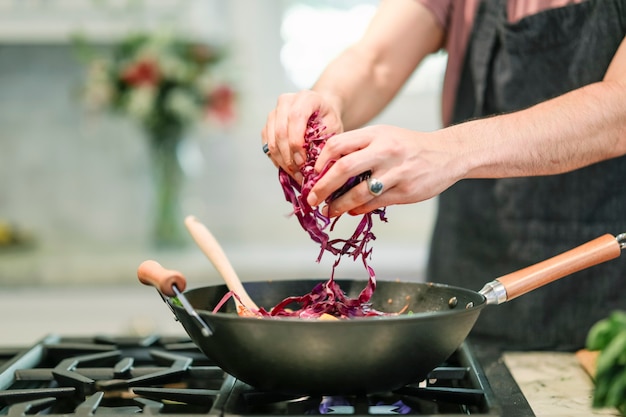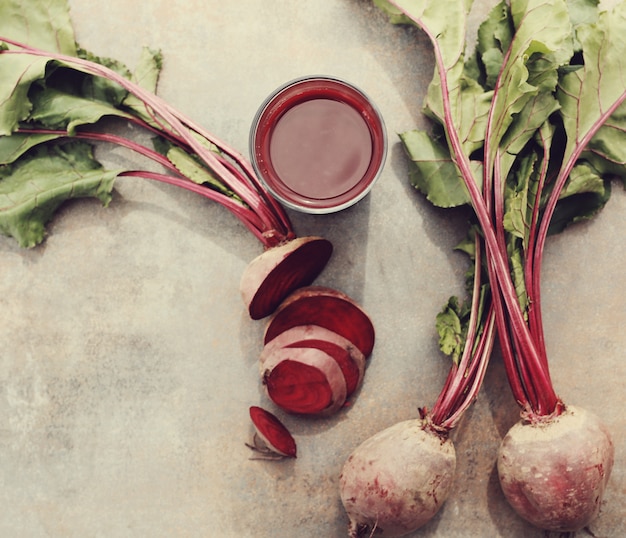Ah, beetroot. That vibrant crimson root vegetable has captured the hearts (and taste buds) of many, popping up in salads, soups, and even smoothies. It's packed with nutrients, adds a splash of colour to any dish, and boasts an earthy, slightly sweet flavour. But cooking beetroot can be a little daunting. That red juice is notorious for staining, and getting the texture just right can be a bit tricky. Don't worry, I've been there! I've had my share of beetroot mishaps, from overcooked mush to crunchy, undercooked monsters. Over time, however, I've learned a few tricks, and I'm excited to share them with you.
This guide is your comprehensive handbook to mastering beetroot on the stovetop. We'll delve into choosing the perfect beetroot, the best cooking methods (boiling, steaming, and roasting), and some handy tips to avoid stains and maximize flavour. Ready to get your hands dirty? Let's get cooking!
(Part 1) Choosing the Right Beetroot

Picking the Perfect Beetroot
The first step to delicious beetroot is selecting the right ones. At the market, look for beetroot that's firm and smooth, with no blemishes or soft spots. The size isn't a major concern, but generally, a beetroot that feels heavy for its size is a good sign. This indicates it's well-hydrated, likely to be tender, and juicy.
While colour isn't a guarantee of quality, it can hint at the flavour. Deep red beetroot tends to have a stronger, more earthy taste, while paler beetroot might be milder. It truly comes down to personal preference.
Don't neglect the leaves! Fresh, vibrant green leaves are a sure sign of a fresh beetroot, which means more flavour. Avoid any that are wilting or yellowing.
Storing Beetroot
Once you've got your beetroot, it's crucial to store them properly to maintain freshness and prevent spoilage. The best way to do this is in a cool, dark place like your refrigerator. For longer storage, wrap them in a damp paper towel or place them in a plastic bag with a few holes poked in it.
Here's a handy tip: If you plan to use them within a couple of days, leave the leaves attached. This helps keep the beetroot hydrated and prevents them from drying out.
(Part 2) Preparing the Beetroot

Washing and Trimming
Before you start cooking, it's essential to give your beetroot a thorough wash to remove any lingering dirt or debris. Gently scrub them with a vegetable brush under running water. Once they're clean, trim the green tops and the root ends. This is also a good time to check for any blemishes and remove them.
You might want to consider removing the beetroot skin before cooking, especially if you're making salads or side dishes where appearance is important. You can do this either before or after cooking, but I find it easier after. The skin tends to come off more readily after the beetroot is cooked.
Cutting the Beetroot
For smaller beetroot, you can cook them whole. However, larger beetroot benefit from being cut into smaller pieces for more even cooking. You can cut them into quarters, wedges, or cubes, depending on your preference.
I personally favour cutting beetroot into wedges. It creates more surface area for absorbing flavours from other ingredients, and it looks elegant in salads and side dishes.
(Part 3) Cooking Methods for Beetroot

1. Boiling Beetroot
Boiling is the simplest and most straightforward way to cook beetroot. Here's what you need to do:
- Fill a large saucepan with enough water to cover the beetroot.
- Add a generous pinch of salt to the water. This seasons the beetroot and helps retain its colour.
- Bring the water to a boil, then gently add the beetroot.
- Reduce the heat to a simmer, cover the saucepan, and let it bubble gently.
- Cook the beetroot until tender. This can take anywhere from 30 to 60 minutes, depending on the size of the beetroot.
- Once the beetroot is cooked, drain them and rinse them under cold water.
To check if the beetroot is cooked, pierce it with a fork or knife. It should slide in easily without any resistance. If you're unsure, cut one open to check. The centre should be soft and cooked through.
2. Steaming Beetroot
If you're looking for a healthier way to cook beetroot, steaming is the way to go. Here's how to steam beetroot:
- Fill a large saucepan with about an inch of water.
- Bring the water to a boil.
- Place a steamer basket in the saucepan, ensuring it doesn't touch the water.
- Add the beetroot to the steamer basket.
- Cover the saucepan and steam the beetroot until tender. This can take anywhere from 20 to 40 minutes, depending on the size of the beetroot.
- Once the beetroot is cooked, remove it from the steamer and rinse it under cold water.
Steaming preserves beetroot's flavour and nutrients better than boiling, and it helps prevent the beetroot from losing its vibrant colour. It's also a fantastic way to avoid those pesky beetroot stains!
3. Roasting Beetroot
Roasting brings out a deeper, more intense flavour in beetroot. Here's how to roast beetroot:
- Preheat your oven to 180°C (350°F).
- Wash and trim the beetroot and cut them into wedges or smaller pieces.
- Place the beetroot on a baking sheet lined with parchment paper.
- Drizzle the beetroot with olive oil and season generously with salt, pepper, and any herbs or spices you like.
- Roast the beetroot for 30 to 45 minutes, or until tender.
- Once the beetroot is cooked, remove it from the oven and let it cool slightly.
You can elevate your roasted beetroot by adding other ingredients to the baking sheet for extra flavour. I love roasting beetroot with garlic, onions, and rosemary for a classic combination.
(Part 4) Handling and Removing the Beetroot Skin
Once your beetroot is cooked, it's time to tackle the skin. This is an important step, as the skin can be tough and bitter. Here are two methods for removing beetroot skin:
1. Peeling by Hand
This is the traditional approach. Let the beetroot cool completely before you begin. Then, use a sharp knife or vegetable peeler to carefully peel away the skin. Be cautious, as beetroot can be slippery.
Tip: If you find hand peeling difficult, try rubbing the beetroot with a clean kitchen towel or paper towel. The skin should come off more easily.
2. The “Soak and Peel” Method
This method is a great way to prevent staining and makes peeling a breeze. Once the beetroot is cooked and cooled, submerge them in a bowl of cold water for a few minutes. The skin will loosen and slide off effortlessly.
Tip: Add a tablespoon of white vinegar to the water. This will help prevent discolouration and make peeling even easier.
(Part 5) Using Cooked Beetroot
Delicious beetroot recipes
The possibilities for enjoying cooked beetroot are endless. Here are some of my go-to recipes:
- beetroot salad: Combine cooked beetroot with your favourite salad greens, feta cheese, walnuts, and a balsamic vinaigrette.
- beetroot hummus: A vibrant and delicious twist on classic hummus. Simply blend cooked beetroot with chickpeas, tahini, lemon juice, garlic, and spices. Serve with pita bread or crackers.
- beetroot soup: A comforting and healthy soup perfect for a chilly evening. Blend cooked beetroot with vegetable broth, potatoes, and your favourite herbs and spices.
- beetroot burgers: For a vegetarian option, try making beetroot burgers. Simply mash cooked beetroot with breadcrumbs, onions, and your favourite spices. Shape them into patties and pan-fry until golden brown.
- Beetroot Relish: A flavourful condiment that is perfect for sandwiches, burgers, and grilled meats. Combine chopped cooked beetroot with onions, vinegar, and sugar and simmer until thickened.
(Part 6) Tips and Tricks for Cooking Beetroot
1. Preventing Beetroot Stains
beetroot juice is a tenacious stain, so it's crucial to take precautions to protect your hands, clothes, and kitchen surfaces. Here are a few tips to help you avoid a beetroot-stained disaster:
- Wear gloves: This is the most effective way to protect your hands. Rubber gloves or disposable gloves will do the trick.
- Use a cutting board: Avoid cutting beetroot directly on your countertops. A cutting board provides a barrier, protecting your surfaces and preventing staining.
- Clean up spills immediately: If you do spill beetroot juice, clean it up as soon as possible. Use a damp cloth or sponge to wipe away the stain before it sets in.
- Use lemon juice: Lemon juice is a natural stain remover. If you get beetroot juice on your clothes, dab it with lemon juice and let it sit for a few minutes before washing.
2. Maximizing Flavour
To ensure you get the most out of your beetroot, here are some tips to enhance its deliciousness:
- Don’t overcook: Overcooked beetroot can become mushy and lose its flavour. Check it regularly with a fork or knife to ensure it’s cooked through but not overdone.
- Season generously: Beetroot is a relatively mild vegetable, so it needs a little bit of flavouring to really shine. Add salt, pepper, herbs, or spices to your liking.
- Use vinegar: Adding a splash of vinegar to the cooking water or roasting pan can help enhance the beetroot's sweetness and brighten its colour.
(Part 7) Beetroot Variations
Different Types of Beetroot
While the deep red beetroot is the most common, there are actually many varieties, each with its own unique characteristics. You can also find golden beetroot, Chioggia beetroot (with white and red rings), and even candy-striped beetroot. They all taste similar, but they differ in colour and appearance.
Beetroot with Other Ingredients
Beetroot pairs beautifully with a variety of ingredients. Experiment with different combinations to find your favourites. Here are some ideas:
- Herbs: Rosemary, thyme, oregano, dill, and parsley all complement the flavour of beetroot.
- Spices: Try adding cumin, coriander, ginger, or cinnamon for an extra kick of flavour.
- Cheese: Feta, goat cheese, and blue cheese all go well with beetroot.
- Nuts: Walnuts, pecans, and almonds add a nice crunch to beetroot dishes.
- Fruits: Apples, oranges, and cranberries can add a touch of sweetness and acidity.
(Part 8) FAQs
1. Can I eat beetroot skin?
It’s best to peel the skin off before eating beetroot, as it can be tough and bitter. However, if you're looking for a way to use the skin, try roasting it with the beetroot. The skin will become crispy and add a unique flavour to your dish.
2. How long does cooked beetroot last in the fridge?
Cooked beetroot can be stored in the refrigerator for up to 5 days. To keep it fresh, wrap it tightly in plastic wrap or store it in an airtight container.
3. Can I freeze cooked beetroot?
Yes, you can freeze cooked beetroot. Simply place it in a freezer-safe bag or container and freeze for up to 3 months. Remember to thaw it overnight in the refrigerator before using.
4. Does beetroot stain my teeth?
Beetroot can indeed stain your teeth. This is due to the natural pigments in the beetroot. To avoid staining, try brushing your teeth after eating beetroot. You can also chew sugar-free gum to help remove any lingering pigments.
5. What are the health benefits of beetroot?
Beetroot is a nutritious vegetable that’s packed with vitamins, minerals, and antioxidants. It’s a good source of folate, potassium, fibre, and nitrates, which have been linked to various health benefits. For example, nitrates may help improve blood flow and lower blood pressure, while fibre can aid in digestion.
(Part 9) Conclusion
Cooking beetroot doesn’t have to be intimidating. With the right techniques and a few tips and tricks, you can easily prepare delicious and nutritious beetroot dishes. Whether you prefer boiling, steaming, or roasting, there’s a method for everyone. So next time you’re at the market, grab some beetroot, and get creative in the kitchen. You’ll be surprised at how versatile and delicious this vibrant root vegetable can be!
Everyone is watching

Corn on the Cob: The Ultimate Guide to Perfectly Cooked Ears
Healthy MealsAh, corn on the cob. Just the name evokes images of sunny days, barbecues, and that sweet, juicy flavour that ...

Scallops: The Ultimate Guide to Perfect Cooking
Healthy MealsAh, scallops. Those delicate, sweet, and utterly delicious morsels of the sea. They hold a special place in my...

Spaghetti Squash: The Ultimate Guide to Cooking and Serving
Healthy MealsRemember that time you saw spaghetti squash at the supermarket, looking all bumpy and strange, and thought, "W...

Salmon Cooking Times: Perfect Guide for Every Recipe
Healthy MealsLet me tell you, cooking salmon is an art form. It's all about getting that perfect balance: juicy and tender,...

Ham Cooking Time: How Long to Bake, Smoke, or Boil a Delicious Ham
Healthy MealsAh, ham. It's a classic, isn't it? A real crowd-pleaser, especially around holidays. And when done right, it'...
